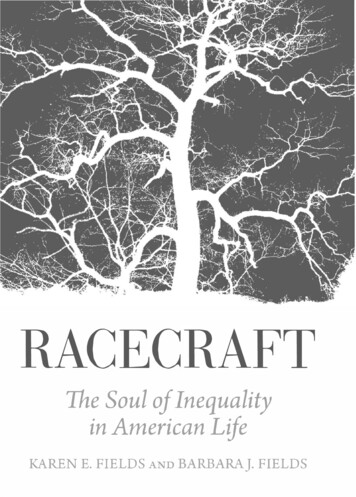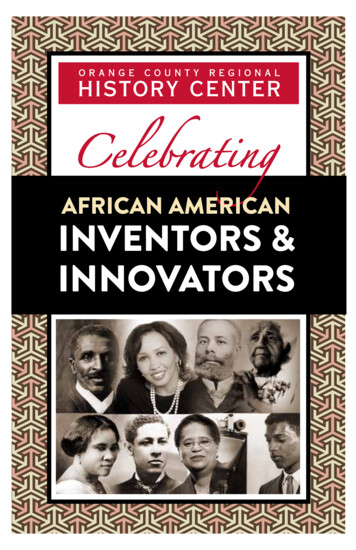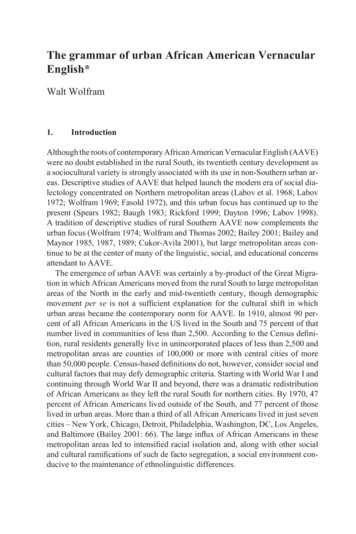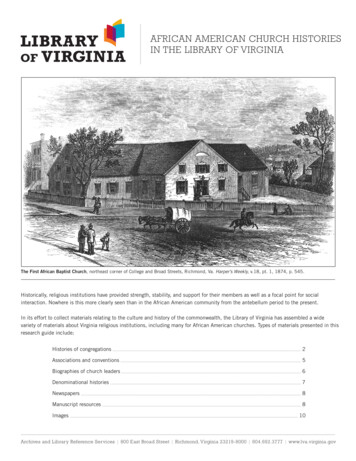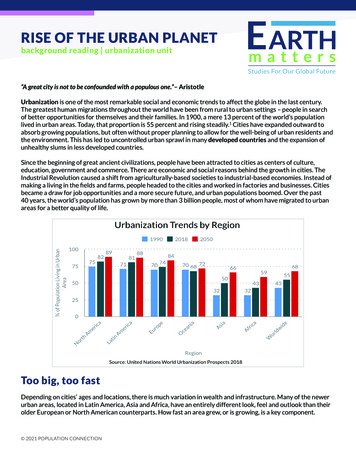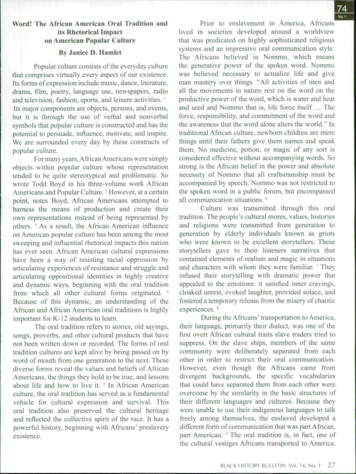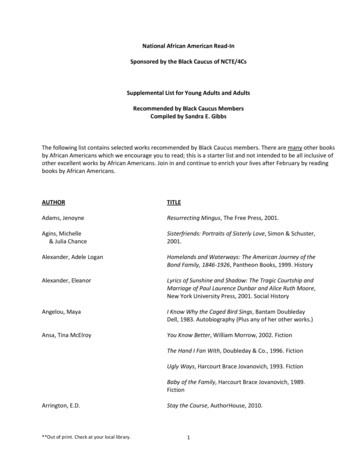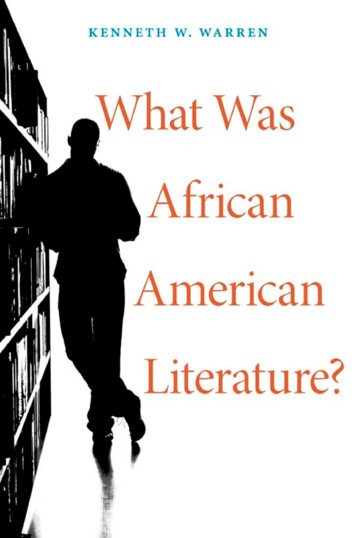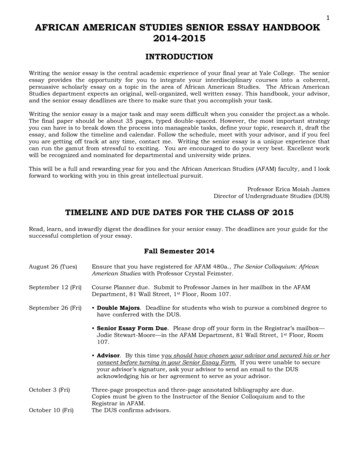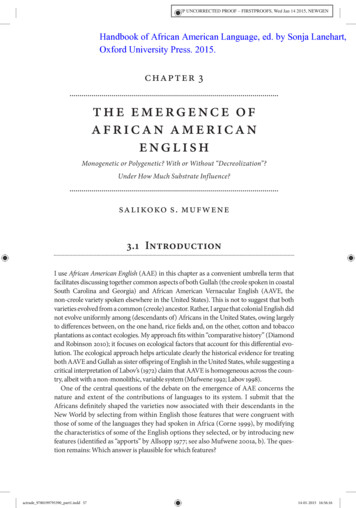
Transcription
OUP UNCORRECTED PROOF – FIRSTPROOFS, Wed Jan 14 2015, NEWGENHandbook of African American Language, ed. by Sonja Lanehart,Oxford University Press. 2015.Chapter 3The Emerg e nc e ofAfrican Ame ri c a nEng l i shMonogenetic or Polygenetic? With or Without “Decreolization”?Under How Much Substrate Influence?SALIKOKO S. MUFWENE3.1 IntroductionI use African American English (AAE) in this chapter as a convenient umbrella term thatfacilitates discussing together common aspects of both Gullah (the creole spoken in coastalSouth Carolina and Georgia) and African American Vernacular English (AAVE, thenon-creole variety spoken elsewhere in the United States). This is not to suggest that bothvarieties evolved from a common (creole) ancestor. Rather, I argue that colonial English didnot evolve uniformly among (descendants of) Africans in the United States, owing largelyto differences between, on the one hand, rice fields and, on the other, cotton and tobaccoplantations as contact ecologies. My approach fits within “comparative history” (Diamondand Robinson 2010); it focuses on ecological factors that account for this differential evolution. The ecological approach helps articulate clearly the historical evidence for treatingboth AAVE and Gullah as sister offspring of English in the United States, while suggesting acritical interpretation of Labov’s (1972) claim that AAVE is homogeneous across the country, albeit with a non-monolithic, variable system (Mufwene 1992; Labov 1998).One of the central questions of the debate on the emergence of AAE concerns thenature and extent of the contributions of languages to its system. I submit that theAfricans definitely shaped the varieties now associated with their descendants in theNew World by selecting from within English those features that were congruent withthose of some of the languages they had spoken in Africa (Corne 1999), by modifyingthe characteristics of some of the English options they selected, or by introducing newfeatures (identified as “apports” by Allsopp 1977; see also Mufwene 2001a, b). The question remains: Which answer is plausible for which features?actrade 9780199795390 part1.indd 5714-01-2015 16:56:16
OUP UNCORRECTED PROOF – FIRSTPROOFS, Wed Jan 14 2015, NEWGEN58 Salikoko S. MufweneWe must bear in mind that the rice fields and the tobacco and cotton plantations generated different population structures, with the latter becoming racially segregated onlyafter the abolition of slavery in the mid-nineteenth century. Owing to the significant“Black majority” (Wood 1974) in the rice fields area, the slaves were already segregatedin the early eighteenth century, which fostered Gullah’s structural divergence from colonial English in the American Southeast. The smaller size of the tobacco and cotton plantations, on which the slaves were generally a minority, and the late institutionalization ofJim Crow appear to have been less favorable to (extensive) substrate influence. Indeed,AAVE and Gullah do not diverge to the same extent from White American SouthernEnglish (WASE), nor does Gullah diverge from the construct “English” to the sameextent as Caribbean English creoles (CECs). Along with Schneider (1995) and Baileyand Thomas (1998), I argue that in fact AAVE and WASE have common origins. Theyappear to have been one and the same regional variety until Jim Crow was introducedin the late nineteenth century and triggered the Great Migration of African Americansout of the South. AAVE was invented as a separate ethnolect in the North, where mostWhite Americans were then getting their first exposure to American Southern English.3.2 Tobacco, Cotton, Rice, and theDifferential Evolution ofEnglish in the United StatesThe colonies of Virginia, very central to the emergence of AAVE, and of South Carolina,critical to the emergence of Gullah, did not start at the same time. The former wasfounded in 1607 directly from England, while the latter started as a “second-generationcolony” (Chaudenson 1992, 2001), settled from Barbados in 1670. Neither settlementevolved overnight into a major slave colony, owing to lack of capital to invest in the plantation industry from the start.1The first Africans, twenty-three acquired from a Dutch frigate, arrived in Virginiain 1619 and had the status of indentured servants, entitled to buy their freedom withina few years. They and the other Africans imported later worked typically as domesticservants in the homes of the wealthiest colonists (Tate 1965). The population then wasnot yet racially segregated, though, to be sure, the Africans were not treated as equal.Still, they had full exposure to the vernacular of the colonists, thanks to regular interactions with them, although, like anybody learning a language naturalistically, theymust have started with interlanguages, which need not be confused with a pidgin as acommunal variety.2 According to Tate (1965), it would not be until about 1675 that theAfricans became slaves, which is about the time the industrial cultivation of tobaccowould develop and the African population started growing rapidly, owing to increasedimportations, for work on the plantations.actrade 9780199795390 part1.indd 5814-01-2015 16:56:16
OUP UNCORRECTED PROOF – FIRSTPROOFS, Wed Jan 14 2015, NEWGENThe Emergence of African American English 59Although, Virginia had the most numerous slave population in the eighteenth century (Rickford 1997), it was actually also the most densely populated colony, totaling53,184 Europeans and 19,800 Africans in 1750 and 288,200 Europeans versus 105,500Africans in 1790. Perkins (1988) and Fischer (1989) estimate that, on average, the Blackpopulation in the Chesapeake hardly exceeded 38 percent of the total colonial population by the end of the eighteenth century. AuCoin (2002) points out that there were acouple of coastal counties (in the swamps) where the Black population reached about60 percent, but this was not the regular pattern. Although, according to Rickford (1997),most of the slaves lived in the coastal area,3 the large tobacco plantations, on which only29 percent of the African population (according to his source) lived, developed inland.According to Kulikoff (1986),By the early 1780s, more than two-fifths of the slaves who resided in eight piedmontcounties organized before 1760 lived on plantations with twenty or more otherslaves. In contrast, more than two-fifths of the slaves of the frontier piedmont counties organized after 1760 still lived on small units of ten or fewer during the early1780s. (337‒39)Only one third of the slaves along the Potomac lived on farms of more than twentyslaves. In Virginia, both James City and York counties were more than 60 percentenslaved in the 1780s. Most of the large plantations in these counties were located inupper Yorkhampton Parish, where more than half the slaves lived on quarters largerthan twenty slaves. Only one third to one fourth lived on big quarters in the rest ofthe counties. (342)The tobacco plantations apparently claimed less than half the slave population, ademographic distribution that suggests non-uniform evolution of English across theAfrican population, as some interacted more frequently with the European coloniststhan others.4 On average a tobacco plantation appears to have had only twenty to thirtyslaves, integrated with the indentured servants, in sharp contrast with a sugarcane plantation in Jamaica, which exceeded one hundred slaves segregated from the Europeancolonists. Thus, the Virginia population structure did not favor the emergence of aCreole slaves’ English that was distinct from that of the locally born White population.Another important factor is that in the eighteenth century, the Virginian slavepopulation grew as much by importation as by birth, with the locally born slavessometimes constituting no less than 40 percent of the relevant population when importations were at their peak (Kulikoff 1986, 335). This entailed more continuity from thepre–eighteenth-century English the Virginians had developed. As argued by DeGraff(1999), Creole slaves were critical agents of feature selection in the emergence of creolesand undoubtedly other varieties now associated with descendants of slaves. They determined by their speech varieties, which would be targeted by the Bozal (African-born)slaves, what particular substrate influences were more likely to become permanent inthe emergent colonial vernaculars.actrade 9780199795390 part1.indd 5914-01-2015 16:56:16
OUP UNCORRECTED PROOF – FIRSTPROOFS, Wed Jan 14 2015, NEWGEN60 Salikoko S. MufweneThe Virginia colony thus conjures up a setting very similar to that of colonial Brazil,with its numerous small sugarcane plantations, where no distinct language variety associated exclusively with the slaves emerged. Quoting H. Jones ([1724] 1956),Kulikoff (1986, 317) reports that “slaves born in Virginia ‘talk good English, and affectour language, habits, and customs.’ ” Likewise, Brasch (1981) reports advertisements inlocal newspapers about runaway slaves of the time that correlate “good English” withbeing born or having lived long in Virginia and “poor, bad,” or “unintelligible” Englishwith recent arrivals from Africa. Virginia is critical to understanding the evolutionof English in the United States because it provided the founder slave population forsecond-generation colonies such as North Carolina, which would develop on its modelrather than on that of South Carolina. The northern colonies had very few slaves, 2 to4 percent of the total colonial population within which they were integrated, though notwith equal social status, as noted above.It is especially noteworthy that the Virginia colony started before that of Barbados(founded in 1627). At the peak of the slave trade during the eighteenth century,American planters imported the overwhelming majority of their slaves straight fromAfrica. These were brought to them by New England merchants, whose ships could sailin a shorter time, straight from West Africa to Virginia and South Carolina, making theacquisition of slaves less expensive for Americans. During the eighteenth century, only10 percent of the enslaved Africans were imported from the Caribbean (Rawley 1991).Equally significant is the fact that the Virginia colony started a little over half a centuryearlier than South Carolina. Even if a creole had developed at the onset of the latter colony, it could hardly have influenced the evolution of English among the African slavesin Virginia, not only because it started later but also because the South Carolinians theninteracted more regularly with Barbadians than with Virginians. Actually, it would alsohave taken substantial migrations of South Carolina slaves to Virginia for the latter’sslave population to change their own way of speaking. No such migration volume hasbeen reported in the history of both colonies.South Carolina itself evolved only gradually into a lucrative plantation colony.Although the first settlement from Barbados in 1670 included some slaves, they werea negligible proportion absorbed by the White population looking for alternativelands and resources, which they could not afford in the colony of origin.5 Initially theyengaged in fur trade and animal husbandry, including cattle ranching and swine raising. According to Edgar (1998, 133), 1,000 out of South Carolina’s slave population of1,800 in 1708 were engaged in this economic activity. Even though rice cultivation hadstarted already by 1700 and the slave population was then equal to that of the Whitepopulation (Wood 1974), the figures indicate that, perhaps owing to insufficient capital,the fields must have still been very small and/or very few in number. As a matter of fact,rice cultivation, begun in the 1690s (Edgar 1998, 140), still competed with the production of indigo, wood, and naval stores. We cannot be surprised that historical records donot mention any Gullah yet, because the dominant homestead socioeconomic conditions did not foster the emergence of a separate English variety among the African slaves(Mufwene 1997a, b, 2000, 2001b).actrade 9780199795390 part1.indd 6014-01-2015 16:56:16
OUP UNCORRECTED PROOF – FIRSTPROOFS, Wed Jan 14 2015, NEWGENThe Emergence of African American English 61Racial segregation was institutionalized in South Carolina in 1720 (Wood 1974), theyear the slave population doubled that of the White population: 21,600 to 9,800 by 1730(Wood 1989). The rice-cultivation industry was then booming again, after slumping inabout 1712 (Edgar 1998, 138), and was turning the colony into the most prosperous onein English North America. The Black population would remain double that of the Whitepopulation until about 1750: 40,600 to 20,000 (Wood 1989). It was only around 1760that the White population started growing faster than the slave population: 57,900 slavesto 38,000 Whites, and it would become the majority by 1790: 108,900 slaves to 140,200Whites, a proportion that would not be eclipsed again.The above demographics raise the question of what made the emergence of Gullahpossible at all, as the disparities in population size do not appear comparable to thosereported for colonies such as Jamaica or Guyana. The answer lies in the population structure: most of the slave population in the eighteenth century was concentrated on the coast(Turner 1949; Wood 1974), where rice cultivation was developing and where the Africansconstituted the overwhelming majority, at the ratio of nine to one. Another question thatarises is: Why did Gullah not diverge from its lexifier to the same extent as Guyanese orJamaican Creole? Part of the answer lies in the rate of population growth and population replacement (Mufwene 2001b): It was apparently slower in South Carolina than inJamaica and Guyana, though future research may shed more light on this issue. By thetime race segregation was institutionalized in 1720, there may have been a relatively largeproportion of English-speaking Creole slaves who would serve as model speakers to theBozal slaves. African linguistic influence would thus work its way only slowly to modifythe colonial vernacular into Gullah, which probably would not become noticeably distinct until the late eighteenth or early nineteenth century. The earliest attestations available are in William Gilmore Simms’s The Wigwam and the Cabin (1845).6We must also bear in mind Rickford’s (1985) comparison of two speakers, White andAfrican American, on Daufuskie Island, South Carolina, which highlights both differences and similarities between them that are generally consistent with observationsabout other former plantation colonies. White and Black Jamaicans sound more likeeach other than like their counterparts in North America, just like a traditional WhiteSoutherner sounds more like an African American Southerner than like a White NewEnglander or Midwesterner. If these observations about coastal South Carolina are correct, the two Daufuskie Island speakers must overall sound more like each other thanlike their hinterland counterparts. Southern English does not include the varieties thatdeveloped in coastal South Carolina and Georgia!The other ecological explanation for why Gullah is less divergent from the construct“English” is to be found in population structure again. While Caribbean sugar cane plantations often grew into huge estates in the eighteenth century, as successful planters boughttheir neighbors out of business (Dunn 1972), South Carolina planters structured their ricefields more on the model of Brazilian sugarcane estates.7 According to Edgar (1998, 142):South Carolina planters seemed to have settled on 30 to 50 slaves as the ideal sizefor a working plantation. Large land and slave owners broke up their holdings intoactrade 9780199795390 part1.indd 6114-01-2015 16:56:16
OUP UNCORRECTED PROOF – FIRSTPROOFS, Wed Jan 14 2015, NEWGEN62 Salikoko S. Mufwenesmaller production units. Ralph Izard Jr., for instance, owned 342 slaves. Therewere 10 slaves at his Charleston town house and 69 at Burton. The remaining 263were divided among five working plantations. Thomas Elliot of St. Andrews Parishhad two plantations and evenly divided his 104 slaves between them. John Ainslieof St. George’s Dorchester, who raised thoroughbreds as well as rice, had 134 slavesat his residence, Windsor Hill and working plantations in St. Paul’s (51 slaves) andSt. Matthew’s (30 slaves).So, if the number of slaves per plantation in South Carolina was not significantly different from that in Virginia, how did Gullah not develop in Virginia, or why did thecoastal South Carolina slaves develop Gullah but not something closer to AAVE? InVirginia, the interior of South Carolina and Georgia, and everywhere else where tobaccoor cotton became the main industrial crop, the slaves were in the minority and race segregation would start only in the late nineteenth century. In coastal South Carolina andGeorgia, they were the overwhelming majority and did not socialize with Whites, evenif they met in the work place. Segregated life left a lot of room for substrate influence toprevail, although the nature of this remains to be determined.There is also a modern observation that bears on the above hypothesis: in SouthCarolina as in Georgia, there is a geographical continuum from Gullah on the coast toAAVE in the hinterlands, which may reflect variation in the kinds of settlements andthe composition of the populations that inhabited them (Mufwene 2001a). The marshesand mosquitoes are the classic explanations for the small population of Whites on thecoast during the colonial period and indeed for the frequent absenteeism of some planters during the summer months. The interior was more hospitable and attractive toindentured servants, who constituted 50 to 75 percent of the southern White population(Kulikoff 1986). According to Kulikoff (1991, 202), “as many as four fifths of all colonists,including their families, servants, and slaves, were farmers.”The position emerging here naturally challenges the claim by, for instance, Morgan(1993) that AAE developed as a “counterlanguage” intended to prevent White masters and overseers from understanding much of what its creators and practitionerssaid. This ignores or downplays the linguistic influence of the White indenturedservants that the field hands interacted regularly with, especially during the homestead phase, although they did not socialize together during the plantation phase.8It does not explain why there are so many structural similarities between AAEand WASE and, ignoring prosodic features, various nonstandard English varietiesin North America and the United Kingdom (Poplack and Tagliamonte 2001). The“decreolization” hypothesis, disputed below as inconsistent with the colonial history,cannot be invoked to account for the similarities. Nor can the Black-nanny theory(invented by British travelers), according to which the linguistic similarities betweenBlacks and Whites in the American South were due to White children being lookedafter by Black nannies. Only 5 to 10 percent of Whites, mostly on the coast, couldafford Black nannies (Coleman 1978). We are left with what follows from the historyarticulated above.actrade 9780199795390 part1.indd 6214-01-2015 16:56:17
OUP UNCORRECTED PROOF – FIRSTPROOFS, Wed Jan 14 2015, NEWGENThe Emergence of African American English 63The above remarks do not entail that African Americans could not have developedcounterlanguages to confuse their masters and overseers. However, in the spirit ofHalliday (1976), such varieties must have been parasitic developments from vernacular English and Gullah varieties that had already emerged naturalistically, just like professional jargons, for instance. They should not be confused with the vernaculars thatemerged as the Africans were forced by the circumstances of their new places of residence to shift to English for communication not only with those who had enslaved thembut also among themselves. It must indeed be informative to compare how Englishevolved among them with how it did among other relocated populations that appropriated English for usage among themselves, such as the Amish, although the latter had notcome to North America in bondage and did not shift languages under identical communicative pressures.3.3 Documentary Evidence3.3.1 Indirect DocumentationThe earliest characterizations of African slaves’ English are to be found in ads posted inlocal papers for the recapture of runaway slaves during the second half of the eighteenthcentury (Brasch 1981). The quotations below suggest that their competence varied fromone speaker to another, corresponding largely to whether they were locally born orAfrican born, and, in the latter case, how long they had lived in the colony:(1) a. Ran away the following negroe’s viz. Sambo, a small, thin visaged Fellow,about 30 years of age, speaks English so as to be understood Aron can’teven speak English Berwick can’t speak English. They have been inabove 8 months in the country. Virginia Gazette, August 24, 1751, p. 3.b. as he was imported very young he speaks very good English. VirginiaGazette, Dec. 12, 1755, p. 4.c. speaks plain for an African born, but avoids looking in the face of themhe is speaking to as much as possible. Rind’s Virginia Gazette, August 8,1788, p. 3.Stewart (1968) and Rickford (1980, 179) comment that, in characterizing the Africans’competence in English as “good,” “tolerable,” or “proper,” the Europeans may have beenlowering their standards. I think that these comments overrate the socioeconomic origins of the overseers who published these ads. Based on Lalla and D’Costa (1990), thekinds of English spoken in some of the plantation mansions, especially those where themasters married down in the lower class, was not particularly standard. English amongthe average Whites was itself predominantly nonstandard and of variable acceptability relative to native British standard norms, bearing also in mind that some of theactrade 9780199795390 part1.indd 6314-01-2015 16:56:17
OUP UNCORRECTED PROOF – FIRSTPROOFS, Wed Jan 14 2015, NEWGEN64 Salikoko S. Mufweneindentured servants were not from England. Some of those coming from Ireland mayhave learned English alongside the African slaves in the colonies.9 Variation in the competence of the overseers is made more evident in Schneider and Montgomery (2001),even if we focus on the grammatical properties of some of the letters and ignore spellinginaccuracies in the examples below. The features include the zero copula, considered as“creole” in, especially, Rickford’s (1998, 2006) and Sutcliffe’s (1998) discussions:(2) a. and we [Ø] Not half Ready [Doyal 3]b. Henry arrive here on yesterday [Meadow 19] (No tense marking!)10c. tooke Seven day to cut [Carter 70] (No number marking with a numeral)More evidence can be found in Tarheel Talk (Eliason 1956), which includes correspondence by various colonists that exhibits many of the same features associated with creoles and AAVE.3.3.2 Direct Colonial DocumentationAdditional supportive evidence lies in the court transcripts of the Salem Witch Trials(1692), in which, incidentally, the speech of an African slave other than the often-citedCandy, in the name of Mary Black, shows no divergence at all from the English of theEuropean colonists, some of whom actually exhibit the same kinds of features now associated with either English creoles or AAVE, as shown below:11(3) a. she choake him (Deliverance Hobbs: no tense marker, or no person/numbermarking)b. Where was you then? (D. Hobbs’s prosecutor: no Subject-Verb agreement)c. you are become a tormentor (D. Hobbs’s prosecutor: auxiliary be insteadof have)d. Where be those images, at your house? (D. Hobbs’s prosecutor: “invariant be”)e. we eate nothing but drunk (Mary Lacy: eat for ate and drunk for drank)f. how maney year (M. Lacy’s prosecutor: no plural marker with a quantifier)g. you say ye Mother was hurt this Spring at e Village (M. Lacy’s prosecutor: Gullah-like uses of possessive ye ‘your’ and e ‘his/her’)Interested readers can find many more examples from the court transcripts, which areavailable at ined. The point of citingall these examples is to underscore Mufwene’s (2000 et seq.) position that one must alsoask oneself whether the so-called “creole features” originated exclusively in languagesother than the European lexifier. The question must be addressed because it is not evident that CECs or Gullah emerged before AAVE (see below).Negative attitudes already in place toward non-Whites during the early eighteenthcentury dispute Stewart’s and Rickford’s lowering-of-standards hypothesis. There simply were slaves who spoke varieties acceptable to Whites. This does not entail that allactrade 9780199795390 part1.indd 6414-01-2015 16:56:17
OUP UNCORRECTED PROOF – FIRSTPROOFS, Wed Jan 14 2015, NEWGENThe Emergence of African American English 65slaves in the seventeenth and eighteenth centuries spoke English natively or fluently,only that they need not have spoken creole(-like) varieties, even those that were Africanborn. The Creole slaves on the tobacco and cotton plantations probably spoke like thelocally born Whites. I am well aware of the inhumane conditions of slavery and of theabusive mistreatments of the slaves, but I also believe that slavery did not incapacitatethe language-learning ability of slaves in immersion, as it were (Mufwene 2005). Norshould we ignore the important numerical size of White indentured servants in theseplantation colonies, who were not necessarily native English speakers. They are the oneswho then interacted regularly with the slaves and who, being the majority labor force,perhaps contributed as much to the emergence of earlier American Southern English(probably the ancestor of AAVE) as the Africans did.3.3.3 First Indirect Postcolonial EvidenceAn important body of indirect12 evidence has been identified in offshoot varieties spoken in Samaná, Dominican Republic (see DeBose 1983), in Liberia (see Singler 1989,1997), and in Nova Scotia (Poplack and Tagliamonte 2001), all identified by the latterauthors “Diaspora varieties.” The premise in invoking features of these varieties as evidence of what AAVE must have been like in the nineteenth century is that they haveremained conservative. Thus, they might provide the missing links that have not materialized in the historical documentary evidence. (For difficulties regarding this assumption, see especially Singler 2007a.)We must indeed speak of the “relevant varieties,” because the populations did notemigrate from the same places in the United States. According to DeBose (1983, 49), “theoriginal settlers [in Samaná] were reportedly from Philadelphia, or a nearby locationsuch as Baltimore or New Jersey.” Singler (2007b) adds to these places Boston, New York,and North Carolina. With the exception of the latter, they are all places outside the plantation colonies where, on average, the slaves constituted a tiny demographic proportionof at most 2 percent (Pennsylvania) per state in 1861 (McPherson 1991, 184),13 and whereoverall they were not residentially segregated (Nash 1988, 169, cited by Singler 2007b,324). To be sure, some of the Samaná settlers originated in southern states, althoughthey were a small minority (Singler 2007b, this volume). The heterogeneity of places oforigin thus underscores the need to consider the post-emigration evolution that tookplace in Samaná (Singler 2007b), as the settlers must undoubtedly have created a newlocal norm, in a process not unlike the koinéization of metropolitan English varietiesearlier in North America.If AAVE spread from the American Southeast to the rest of the United States with theGreat Migration of the early twentieth century (see below), then, based on the information available on the settlers’ places of origins, Samaná English and similar Diasporavarieties must reflect a working-class American English that has changed in the homeland since some time in the nineteenth century. It need not reflect a creole ancestor ofAAVE, contrary to DeBose’s (1983) conclusion. Regardless of whether or not the dataactrade 9780199795390 part1.indd 6514-01-2015 16:56:17
OUP UNCORRECTED PROOF – FIRSTPROOFS, Wed Jan 14 2015, NEWGEN66 Salikoko S. Mufwenecollected by DeBose and other students of Samaná English are truly vernacular (Singler2007a), the features discussed by DeBose and other proponents of the “DecreolizationHypothesis” need not be characterized as exclusive creole peculiarities. They may represent homologous overgeneralizations after the institutionalization of race segregation inthe relevant Anglophone territories, and, in the case of Samaná English, after geographical separation from its Anglophone homeland.Thus, while the zero copula has survived in CECs and AAE, there is only partial evidence of it in White nonstandard English. Non-rhoticity appears to have been one of thevariants in the United States. Rhoticity has been reported to be a late development, probably of the twentieth century, among White southerners. Subject-verb disagreement andconsonant cluster simplification are still well attested in some White American nonstandard English varieties and elsewhere. On the other hand, features such as negation withain’t, you is, and I’m never been are not part of CECs’ basilectal structural repertoires.Nor is the apparent reanalysis of the fusion of the contracted copula with the subjectpronoun in constructions such as I’m, dat’s, it’s, or what’s into a monomorphemic variant of the subject pronoun when they are followed by a nonverbal predicate (as in that’snice pronoun zero copula predicate adjective). It is not evident why theseparticular structural peculiarities are invoked to argue for a creole ancestry of AAVE.It is thus not surprising that, as they focused
The Emergence of African American English 59. Although, Virginia had the most numerous slave population in the eighteenth cen-tury (Rickford 1997), it was actually also the most densely populated c

